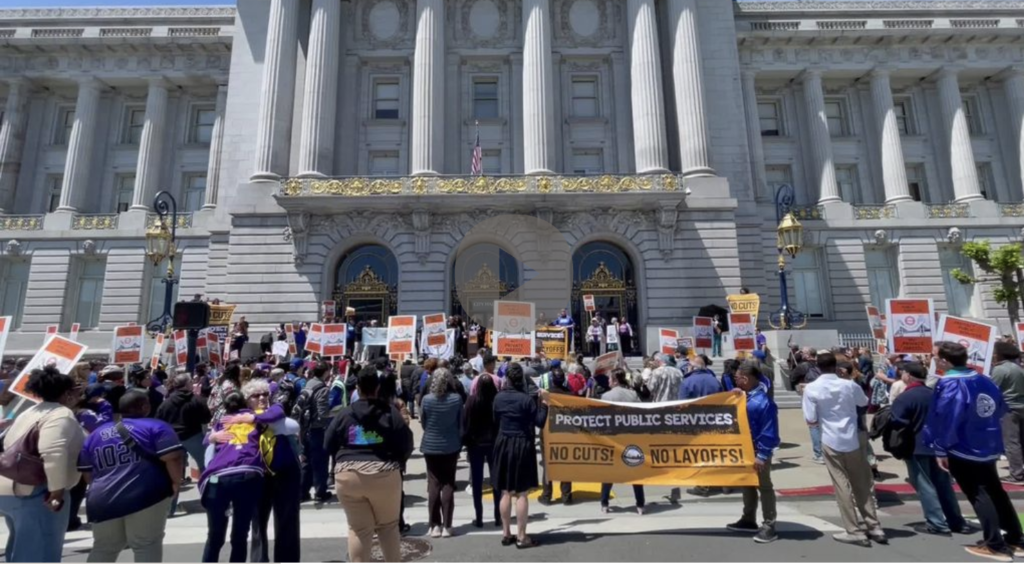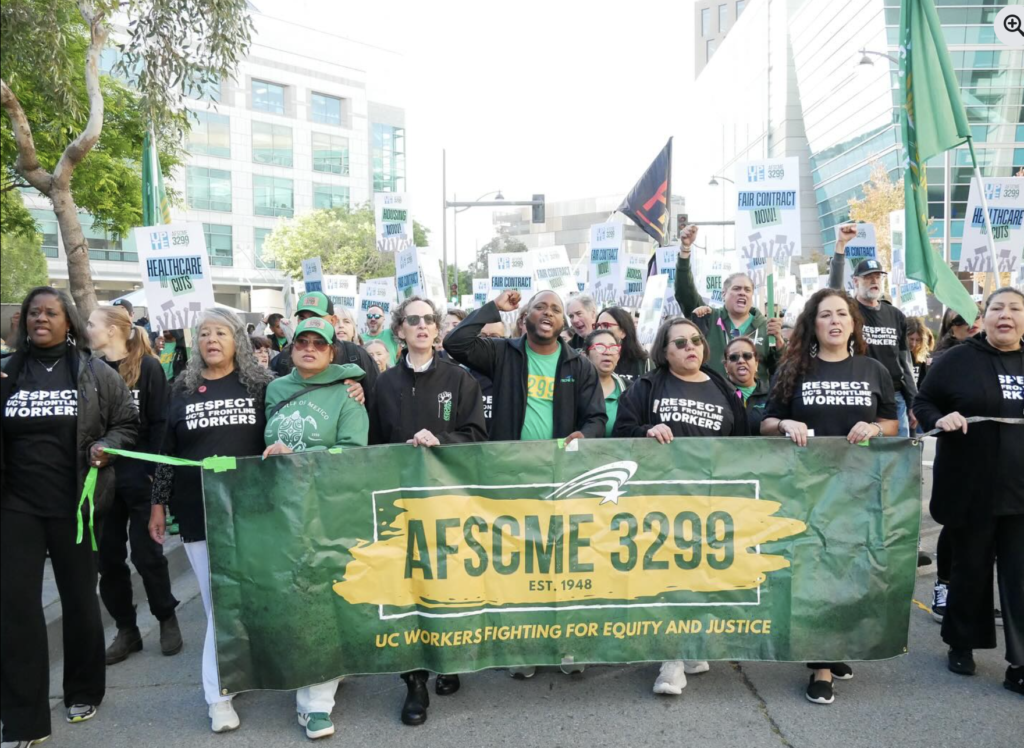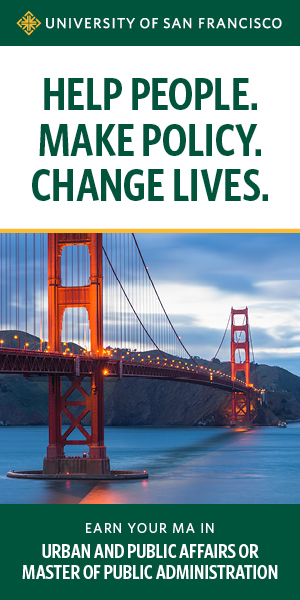Mayor Daniel Lurie and Gov. Gavin Newsom are facing budget crises that threaten basic services, and as they prepare for brutal cuts, they are also facing a serious adversary: Organized labor.
In rallies at City Hall and at the last Board of Regents meeting, broad coalitions of local and statewide union members have opposed the deep cuts that have already impacted essential programs and may lead to layoffs.
On May 14, more than 1,000 city workers essentially took over City Hall with a boisterous rally that included a banner drop over the rotunda—aimed directly at Lurie.

The next day, more than a dozen local and state labor leaders, including Lorena Gonzalez, president of the California Labor Federation, were arrested at a meeting of the Board of Regents demanding adequate staffing at the University of California system, particularly health staffing at UCSF. That rally was aimed directly at UC leadership—but also at Newsom, who controls the system’s budget.
Now Newsom is talking about austerity cuts, and Lurie is setting aside another $400 million from the General Fund to prepare for a loss of federal money. That may not be enough.

The labor leaders have allies in both the state Legislature and the Board of Supes; Budget Chair Connie Chan won re-election with strong labor support. And from the tone and participation in the two rallies so far, it appears that much of the state and local labor movement is together on avoiding service cuts (and cutting workers).
At the local level, labor groups are talking about the efforts by big tech companies to avoid paying taxes to the tune of more than $300 million. I have seen nothing from anyone in the state Legislature suggesting ways to bring in more money.
But at some point, that has to be on the table—and it’s interesting to see how this is playing out in the New York mayor’s race.
In a somewhat stunning turn of events, New York Assemblymember Zohran Mamdani is running a close second to formerly disgraced Gov. Andrew Cuomo in the June Democratic primary. Mamdani, a socialist, is close to a statistical tie for the lead, polls show, and in a ranked-choice-voting race, he could emerge on top.
The primary winner will likely be the city’s next mayor.
Mamdani has an ambitious agenda, including free bus service , universal child care, affordable housing and more. He’s also offering a specific plan to pay for it, and to make up for the federal cuts the city will face, with a plan to tax big corporations and wealthy individuals who will benefit from Trump’s tax cuts.
(Interesting note: Trump and his allies aren’t even bothering to pretend any more that so-called “trickle-down” economics will make us all better off. He’s just calling for tax cuts on the rich for the sake of making a few people richer; there’s not even a remote suggestion that this could help anyone else.)
Here’s Mamdani:
The wealthy have seen a steep decline in their tax rates over the last 60 years, but no one has sought to rob the poor and give to the rich as much as Donald Trump. The first Trump administration’s signature accomplishment was a tax cut for corporations and millionaires—a cut that has already cost our country trillions of dollars. Now, Donald Trump wants more tax cuts that will cost $4 trillion over the next ten years. Congressional Republicans are committed to pushing these through, even if it means cutting trillions of dollars in spending on Medicaid, food stamps, public schools, public transportation, and more.
So what, he says, should local communities do?
Put simply, we have no choice but to fight back and protect
everyday New Yorkers. And fighting back means finding a way to fund an agenda that allows working people to thrive amidst Trump’s chaos: affordable housing, fast and free buses, universal childcare, safe streets and subways, and more. The Mamdani administration has a plan to pay for this agenda by raising taxes on the most profitable corporations and the wealthiest New Yorkers, reversing decades of tax cuts and disinvestment.
Specifically, Mamdani is calling for
Raising the top state Corporate Tax rate to 11.5 percent—the same rate as New Jersey’s. Raises $5 billion a year.
Adding a 2 percent New York City Income Tax for anyone making more than $1 million a year. Raises $4 billion a year.
Why?
New York’s budget is almost ten times the size of San Francisco’s, as is the population.
The top 1 percent of NYC taxpayers—about 34,000 households—earn over $1 million each year. This tiny share of the city population takes home 35 percent of all income earned by New York City residents. The top 1 percent also benefited from a large income tax cut under Trump’s first tax bill, when their tax rate was cut from 39.6 percent to 37 percent. This tax cut is likely to be extended in the next federal budget, at a cost of $3.6 trillion.
The same pattern is true in San Francisco—the very rich take home a huge share of the total income earned in the city, and own a vast percentage of all the wealth.
California has almost 200 billionaires—more than any other state, including New York.
So: There’s a way to address our budget problems without cuts to services, just by making the people who benefit from the Trump tax cuts pay a little bit more. (No, the data shows, they won’t move; in fact, they’ll do just fine.)
I don’t expect Lurie to talk about this, or Newsom—but labor folks, and some of the supes, and some of the state legislators, could at least raise the issue. Taxing the rich on a local and state level is not that radical; it might even get a socialist elected mayor of New York.



